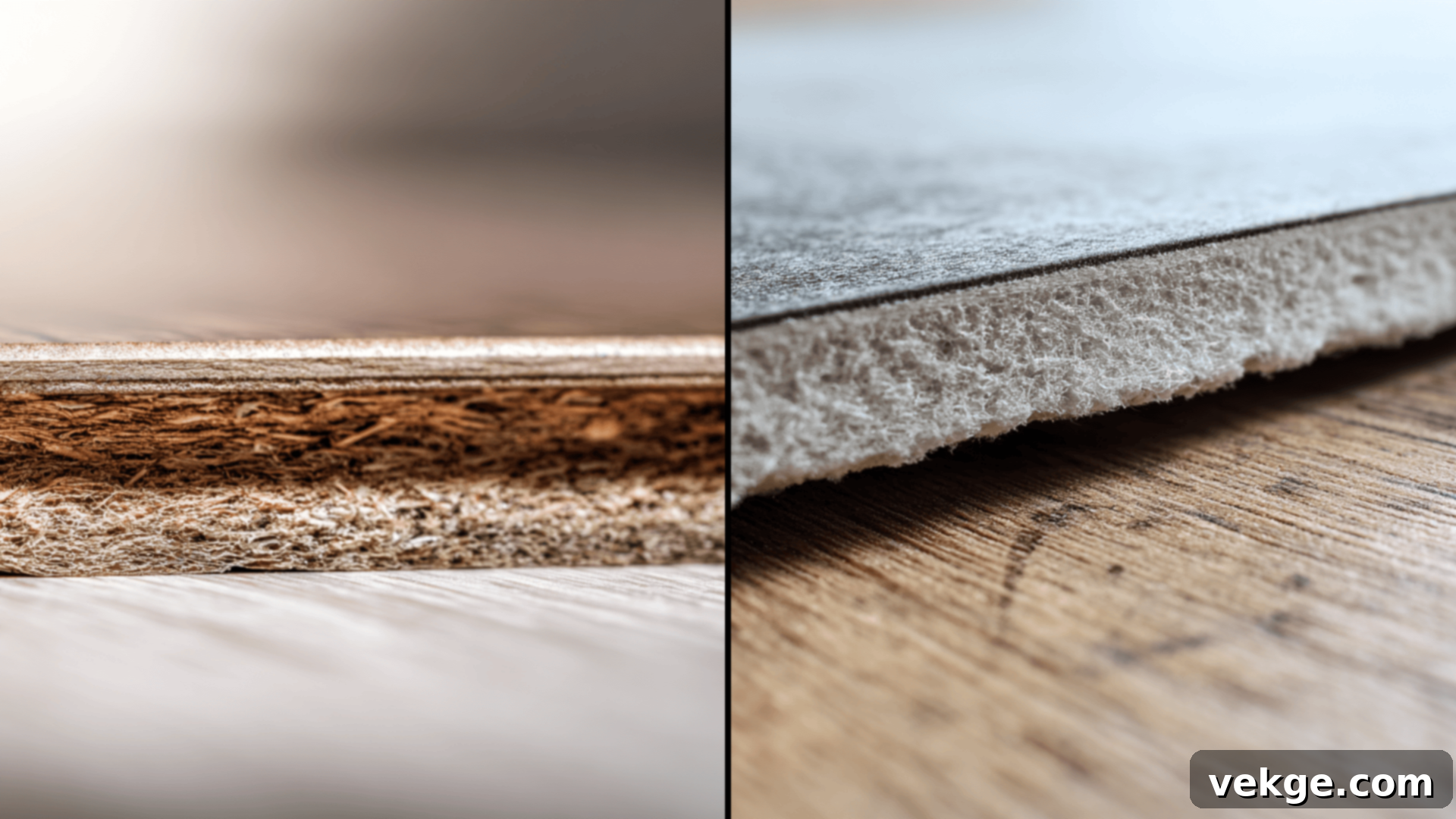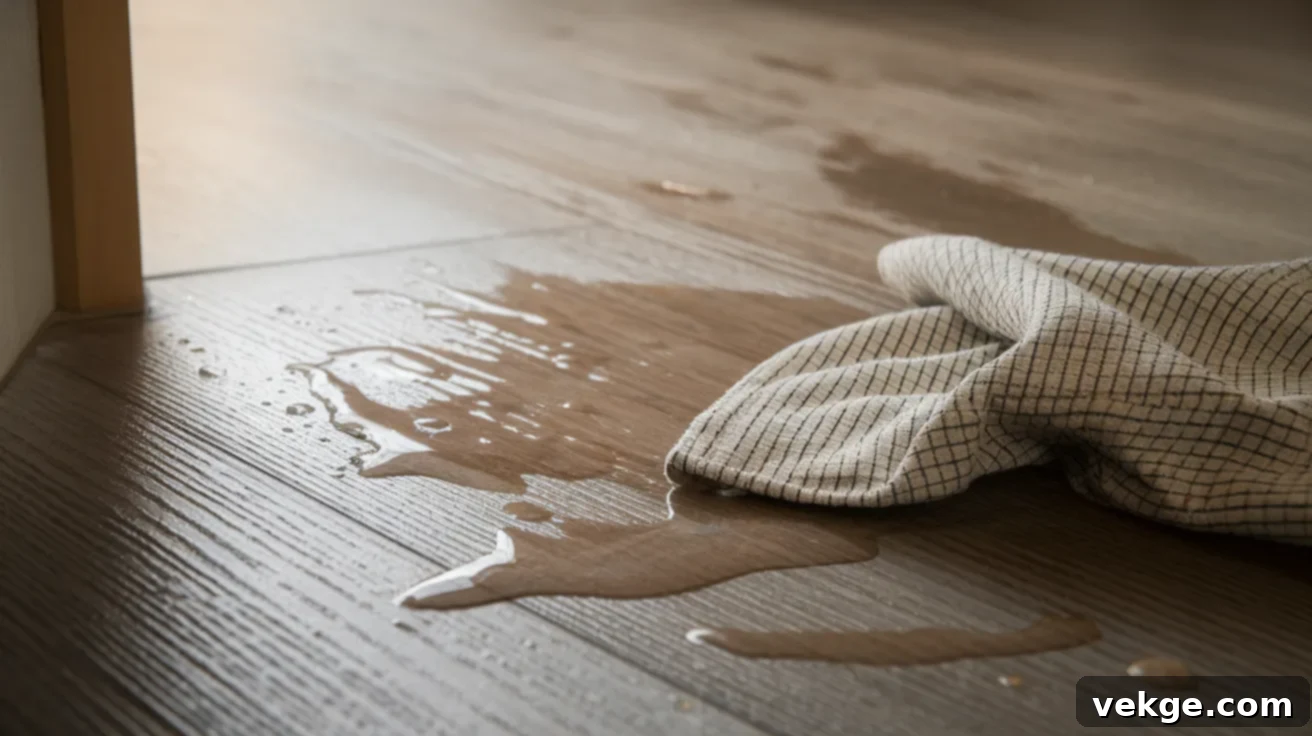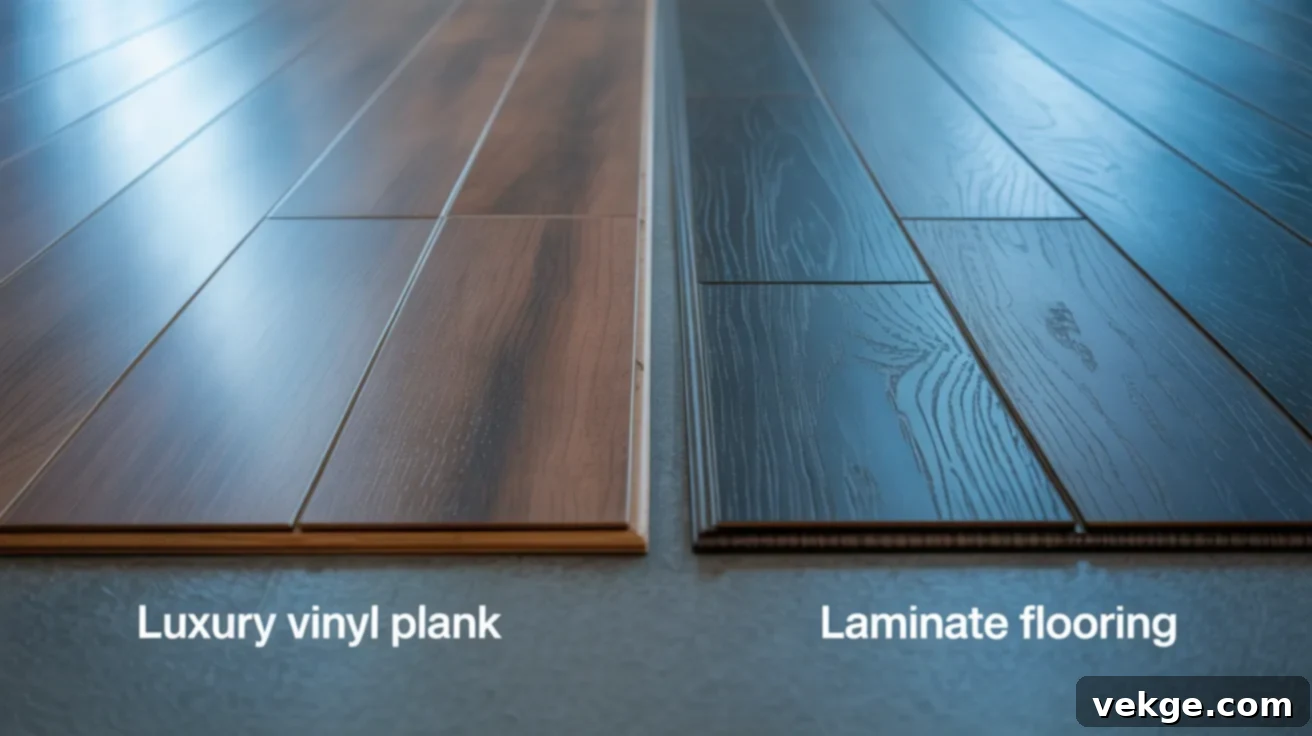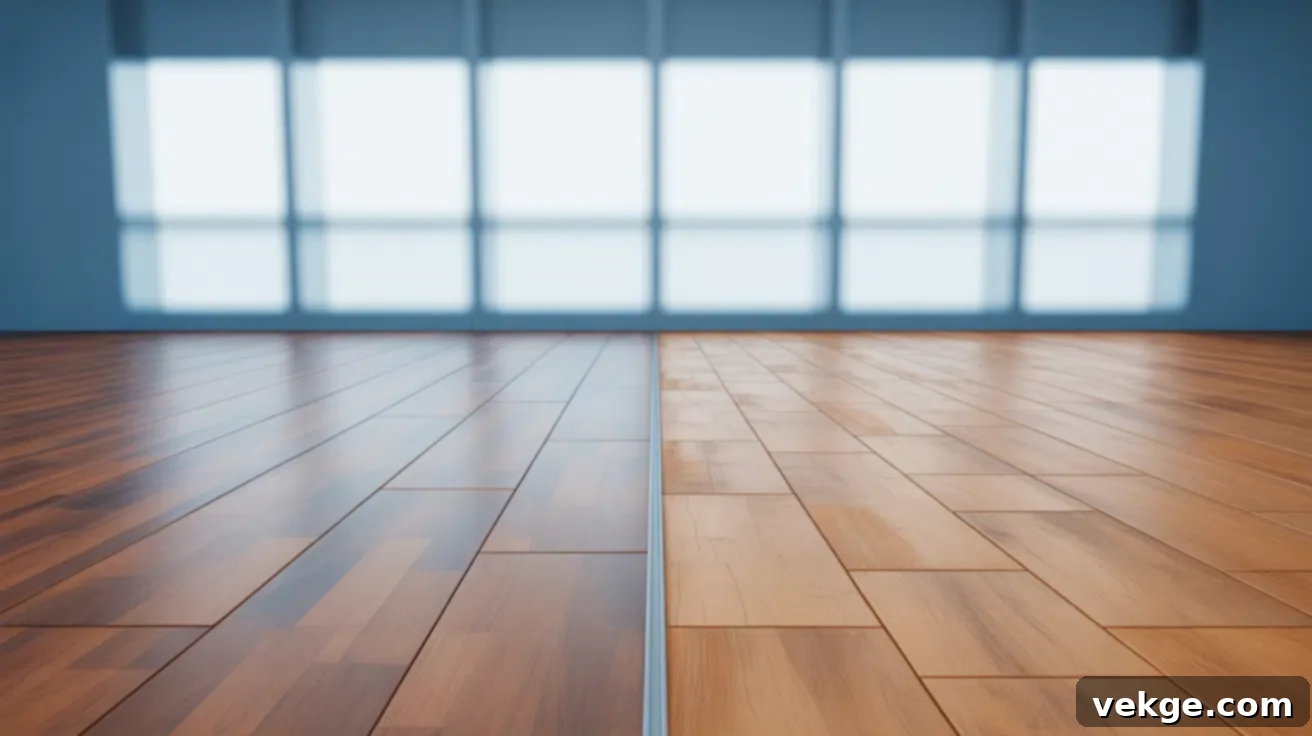Vinyl vs. Laminate Flooring: The Ultimate Guide to Telling the Difference
Many homeowners find themselves staring at their floors, asking, “Is this vinyl or laminate?” It’s a surprisingly common dilemma. These two popular flooring options often look so similar that even seasoned homeowners or those who’ve lived with them for years struggle to tell them apart. From a distance, their realistic wood or stone appearances can be incredibly deceptive, leading to widespread confusion.
However, knowing the precise difference between vinyl and laminate flooring is more than just a trivial detail. It significantly impacts critical aspects of home maintenance, including how you clean your floors, the specific products you should use, and even the overall lifespan and performance you can expect. Using the wrong cleaning method or product can lead to irreversible damage, diminish your floor’s aesthetics, and potentially void its warranty.
This comprehensive guide is designed to equip you with all the knowledge you need. We’ll delve into simple, no-tool tests you can perform right now to confidently identify your flooring type. You’ll also gain insight into how each material feels underfoot, where it performs best in a home environment, and why these distinctions are crucial for long-term home care and investment protection. Let’s clear up this common confusion once and for all, ensuring that guesswork plays no part in your home maintenance routine.
Why Vinyl and Laminate Floors Are So Easy to Confuse
The primary reason for the persistent confusion between vinyl and laminate flooring lies in their fundamental design objective: both are engineered to convincingly mimic the appearance of natural materials like hardwood, ceramic tile, or stone. Modern manufacturing techniques have become so advanced that, at a glance, these synthetic options can indeed fool just about anyone. They achieve their realistic looks by utilizing high-definition photographic layers, which are then protected by durable wear layers, making visual identification challenging.
Beyond aesthetics, their market positioning further blurs the lines. Vinyl and laminate typically fall within similar price ranges, making them competitive alternatives for budget-conscious homeowners. You’ll frequently find them displayed side-by-side in flooring showrooms, which only intensifies the perceived similarity. Adding to this, many people, including sometimes even contractors or friends, use the terms “vinyl” and “laminate” interchangeably, perpetuating incorrect information.
Despite these overlapping characteristics, once you understand the core differences in their composition and how to apply a few practical tests, the distinctive signs become surprisingly straightforward to spot. Let’s break down the key, reliable methods to accurately distinguish between these two popular flooring materials.
How to Easily Tell the Difference Between Vinyl and Laminate Flooring: Simple Tests
You don’t need specialized tools or professional help to identify your flooring. By engaging your senses—sight, touch, and hearing—you can conduct a series of quick, effective tests that will help you distinguish between vinyl and laminate flooring with confidence. Dedicate a few minutes, and you’ll be able to make an informed assessment without any guesswork.
1. The Tap Test: Listen Closely to the Sound

One of the simplest and most telling initial tests involves listening to the sound your floor produces. Gently tap the surface of your floor with your knuckles or a coin. Pay close attention to the acoustic response:
- Laminate Flooring: Due to its high-density fiberboard (HDF) core, laminate typically produces a more hollow, resonant, or echo-like sound. It often sounds similar to tapping on a hollow piece of wood, a cabinet door, or even a hard plastic surface. You might also notice it has a slight “bounce” or reverberation to the sound. This is because the core is less dense and transmits sound differently than a solid plastic core.
- Vinyl Flooring: In contrast, vinyl flooring, especially luxury vinyl plank (LVP) or luxury vinyl tile (LVT), tends to sound much softer and more muted. Because it’s primarily made of PVC (polyvinyl chloride), a type of plastic, it has a denser, more uniform construction. This often results in a duller thud or even a slightly rubbery tone when tapped. The sound absorbs rather than echoes, giving it a more solid, less resonant feel.
Give it a quick, light knock. Once you know what distinct sounds to listen for, the difference can be surprisingly clear and is often a strong indicator of your flooring type.
2. The Feel Test: Explore the Texture and Temperature Underfoot

Your sense of touch can be a remarkably accurate tool for identification. Try walking barefoot across your floor, or at least run your hand over its surface. Pay attention to both the texture and the temperature:
- Laminate Flooring: Laminate generally feels firmer and harder underfoot. Because its core is made of compressed wood fibers, it doesn’t offer much give. Many modern laminates feature embossed textures that closely mimic the grain of real wood or the grout lines of tile, giving it a distinct, often slightly raised texture that you can feel. It also tends to feel a bit warmer to the touch than vinyl, as wood fibers are better insulators than plastic.
- Vinyl Flooring: Vinyl typically feels smoother and often a little softer or more flexible. High-quality vinyl may have some subtle embossing, but its overall composition makes it inherently less rigid. It often feels cooler to the touch compared to laminate, especially in colder rooms, due to its plastic composition. This cooler, smoother sensation is often quite noticeable, particularly if you compare it to a laminate sample.
Many people find that the difference is much more apparent through their feet than through their eyes alone. This tactile test is often my go-to method when visual cues aren’t definitive.
3. The Edge Peek Test: Examine the Core Material

This method offers one of the most definitive ways to tell vinyl and laminate apart, as it reveals the core composition of the material. If you can safely access an exposed edge of the flooring – perhaps by carefully lifting a floor vent cover, inspecting a gap near a wall, or loosening a piece of transition trim – take a close look at the cross-section:
- Laminate Flooring: Almost without exception, laminate flooring will expose a core made of high-density fiberboard (HDF) or medium-density fiberboard (MDF). This looks like compressed wood particles, typically brownish or greenish, depending on the manufacturer and moisture resistance treatments. You can often see the distinct fibrous texture of the wood particles. This brown, wood-based layer is a dead giveaway for laminate.
- Vinyl Flooring: Vinyl flooring, on the other hand, will reveal a more plastic-looking core. This core is usually solid and uniform, often appearing grey, white, or even the same color as the top layer. It might be composed of multiple layers of PVC, giving it a layered but cohesive, non-fibrous appearance. The absence of wood fibers and the presence of a uniform plastic material strongly indicate vinyl.
If you’re still uncertain after the tap and feel tests, this edge check is often the quickest and most reliable way to definitively clear things up, as it directly exposes the material’s fundamental construction.
4. The Splash Test (Optional and with Caution)

This test is highly effective but should be performed with extreme caution and only in a very hidden, inconspicuous area that is out of sight and won’t cause permanent damage if it turns out to be laminate. The goal is to observe how the flooring reacts to prolonged moisture:
- Vinyl Flooring: If it’s vinyl, especially modern luxury vinyl, it is inherently 100% waterproof. When you place a damp cloth or sponge on it for a few minutes, you will observe no change whatsoever. The water will simply sit on the surface, and the material will remain completely unaffected.
- Laminate Flooring: Laminate, due to its fiberboard core, is generally water-resistant but not waterproof. If water seeps into its seams or prolonged moisture penetrates the protective layer, the fiberboard core can absorb the water. This absorption will cause the laminate to swell, bubble, or warp. Even a small amount of water left for a short period can lead to noticeable damage, making this a risky test if you suspect laminate.
I’ve used this as a last resort in very discreet spots, such as a corner hidden by furniture or inside a closet. If you are feeling highly unsure after the other tests, this can help confirm your suspicions, but always proceed with a full understanding of the potential for damage to laminate.
Key Differences Between Vinyl and Laminate Flooring at a Glance

While visual similarities can be misleading, vinyl and laminate floors diverge significantly in their composition, performance, and ideal applications. Understanding these core distinctions is vital for making informed decisions, from proper maintenance to selecting the right flooring for different areas of your home. This table summarizes the critical features that set them apart:
| Feature | Vinyl Flooring | Laminate Flooring |
|---|---|---|
| Composition | Made primarily from PVC (polyvinyl chloride) layers, often with a rigid core (WPC, SPC) and a wear layer. | Composed of a fiberboard (HDF/MDF) core, topped with a photographic layer and a clear wear layer. |
| Appearance | Excellent mimicry of wood or stone; wide variety of realistic patterns, often with fewer repeats due to advanced printing. | Realistic wood or tile looks; patterns can sometimes repeat more frequently across a large area. |
| Feel and Texture | Softer, more resilient, and often cooler to the touch; slightly flexible underfoot, offering more comfort. | Harder, more rigid, and typically warmer to the touch; firmer underfoot with less give. |
| Water Resistance | Fully waterproof; ideal for kitchens, bathrooms, basements, and other high-moisture areas. | Water-resistant (not waterproof); susceptible to swelling and damage if water penetrates the core; not ideal for wet areas. |
| Durability and Longevity | Highly resistant to scratches, dents, and scuffs; excellent for homes with pets and high traffic. Can last 10-20+ years. | Durable against daily wear but prone to chipping, scratching, and irreparable swelling from water. Can last 10-25 years in dry, well-maintained areas. |
| Installation Methods | Available in click-lock, glue-down, or peel-and-stick formats. Often easier for DIY installation. | Primarily uses a click-lock (floating floor) system; typically requires underlayment. |
| Cost Comparison | Ranges from budget-friendly sheets to higher-end luxury vinyl planks/tiles; waterproof features can increase cost. | Generally more affordable for basic styles; advanced aesthetics and features can increase price. |
| Maintenance Needs | Easy to clean with a damp mop, warm water, and mild detergent; highly resistant to spills. Avoid abrasive cleaners. | Requires dry mopping or specific laminate-safe cleaners; avoid excessive water to prevent damage. |
Still Can’t Tell Vinyl and Laminate Flooring Apart? Try These Expert Tips
Even after performing the hands-on tests, some flooring can be particularly ambiguous. If you’re still not getting a clear answer, don’t despair! There are several additional resources and expert opinions you can leverage to finally get a definitive identification:
- Call a Flooring Store with a Close-Up Photo: Take several high-resolution photos of your flooring, especially focusing on a close-up of the surface texture, any visible edges (like near a vent or wall), and a general shot of the room. Many experienced flooring specialists can often identify the material type just by analyzing the grain, pattern repetition, or perceived depth in a detailed photograph.
- Ask the Previous Homeowner or Landlord: This is often the most direct route. If you have contact with the previous owner or your landlord, they might still have original receipts, installation documents, or simply remember what type of flooring was installed during renovations. This eliminates all guesswork.
- Bring a Corner Sample to a Local Hardware Store: If you can safely and inconspicuously remove a small piece of the flooring (e.g., from an unseen corner in a closet or under an appliance), take it to a local hardware store or flooring showroom. Most flooring specialists possess the expertise to quickly examine the cross-section and wear layer to accurately identify the material in seconds.
- Check Under a Floor Vent or Threshold Strip: As mentioned in the “Edge Peek Test,” these areas often provide the clearest view of the flooring’s core material. Carefully lift a floor vent or gently pry up a threshold strip. The exposed side profile will clearly show if it’s the fiberboard characteristic of laminate or the layered PVC of vinyl.
- Look Up Your Home’s Renovation Records or Real Estate Listings: Sometimes, real estate listings or home inspection reports from when you purchased the property might contain details about the installed flooring. Property renovation permits or records with your local municipality could also list major updates, including flooring installations.
Why It Is So Important to Know the Difference
Knowing whether you have vinyl or laminate flooring transcends simple curiosity; it’s fundamental to effective home maintenance and protecting your investment. Each flooring type has distinct needs and vulnerabilities, and understanding these differences is crucial for several reasons:
- Correct Cleaning and Maintenance: This is perhaps the most immediate impact. Vinyl and laminate require vastly different cleaning approaches. Vinyl, being waterproof, tolerates damp mopping with a wide range of cleaners. Laminate, with its wood-fiber core, is highly susceptible to water damage, necessitating dry cleaning methods or specialized, low-moisture laminate cleaners. Using a harsh, wet mop on laminate can cause irreversible swelling, delamination, and warping, while using a residue-leaving cleaner on vinyl might dull its finish.
- Preventing Costly Damage: Guessing your floor type and applying incorrect care methods can lead to significant and expensive damage. For instance, a single major spill left unattended on laminate can cause permanent bubbling and lifting. Similarly, using the wrong type of protective pads under furniture or abrasive cleaners can prematurely wear down the protective layers of both, reducing their lifespan and aesthetic appeal.
- Accurate Repairs and Replacements: If a plank or section of your floor becomes damaged, knowing its exact type is essential for repairs. Vinyl planks are not compatible with laminate planks, and vice-versa. Attempting to mix them will lead to improper fit, gaps, and an uneven appearance. Correct identification ensures you purchase the right replacement materials that match your existing floor’s composition and interlocking system.
- Informing Future Renovations and Home Value: The waterproof nature of vinyl makes it ideal for areas like bathrooms, kitchens, and basements. Laminate, while durable, is best suited for drier living areas. This distinction impacts renovation planning and even the perceived value of your home. A fully waterproof vinyl floor in a kitchen might be a selling point, whereas a laminate floor in the same area could be a red flag for potential buyers due to its moisture vulnerability.
- Warranty Compliance: Many flooring manufacturers specify strict cleaning and maintenance guidelines in their warranties. Using improper cleaning agents or methods can often void your warranty, leaving you without recourse if your floor experiences issues down the line.
Ultimately, a few minutes spent identifying your flooring now can save you countless hours, stress, and money in preventable repairs and replacements in the future.
Common Mistakes to Avoid When Dealing with Vinyl and Laminate Flooring
Even after learning the key differences, it’s easy to make mistakes if you’re not careful. Being aware of these common pitfalls can help you maintain your floors properly and avoid unnecessary damage or costs:
- Using the Wrong Cleaner: This is the most frequent and damaging mistake. Applying harsh, acidic, abrasive, or oil-based products on either vinyl or laminate can strip the protective wear layer, leave sticky residue, dull the finish, or even cause discoloration. Always use cleaners specifically formulated for your identified floor type, or stick to simple warm water and a mild, pH-neutral detergent for vinyl, and a dry mop or laminate-safe spray for laminate.
- Guessing the Floor Type: Rushing to judgment without performing the identification tests can lead to a cascade of errors. If you guess wrong, you’ll likely use incorrect cleaning methods, choose incompatible replacement planks, or make poor decisions regarding moisture exposure, all of which can severely compromise your floor’s integrity and appearance.
- Skipping Underlayment Checks: While some luxury vinyl planks come with integrated underlayment, most laminate floors and certain vinyl products require a separate underlayment. Ignoring this need can lead to significant issues like excessive noise (hollow sound), diminished comfort underfoot, and inadequate moisture protection from the subfloor, potentially voiding warranties. Always check the manufacturer’s specific requirements.
- Mopping Laminate with Too Much Water: This cannot be stressed enough. Laminate’s fiberboard core is highly susceptible to water damage. Using an overly wet mop, allowing standing water, or even frequently damp mopping can cause the edges and seams to swell, buckle, and permanently damage the planks. Always wring out mops thoroughly until barely damp, or opt for a dry or specialized laminate mop.
- Ignoring Edge Clues: While surface appearance can be deceptive, the core material revealed at the edges (under vents, transitions, or baseboards) is the most definitive indicator. Overlooking this simple check in favor of visual guesses can lead to incorrect identification and subsequent improper care.
Taking a few extra minutes to double-check your floor type and adhere to appropriate care routines can prevent long-term damage and save you from costly repairs or premature replacement. Small, informed steps now lead to significant savings and a longer-lasting, beautiful floor later.
Final Thoughts
With the knowledge you’ve gained about how to tell the difference between vinyl and laminate flooring, you are now empowered to make more intelligent, informed decisions regarding your home’s upkeep. This understanding goes beyond simply identifying materials; it’s about confidently protecting your investment, avoiding common and costly mistakes, and ensuring the longevity and beauty of your living spaces.
We’ve explored the fundamental compositions of each material, identified their ideal applications, and walked through a series of simple, no-tool tests that you can perform yourself. From the distinct sound of a tap to the tactile sensation underfoot and the revealing view of a plank’s core, these checks, though seemingly small, collectively provide a robust framework for accurate identification.
Embracing these insights will save you time, money, and frustration in the long run by guiding you toward the correct cleaning methods, repair strategies, and overall care practices. Feel confident about what’s under your feet, and enjoy the peace of mind that comes with proper home maintenance.
If this guide has proven helpful, we invite you to explore more hands-on, real-world home care and renovation tips available right here on our website.
Frequently Asked Questions About Vinyl and Laminate Flooring
Can I mix vinyl and laminate flooring in different rooms?
Yes, absolutely. It’s common to use different flooring types in various rooms to suit specific needs (e.g., waterproof vinyl in bathrooms, laminate in living areas). However, it’s crucial to use appropriate transition strips or reducers between the different floor types to accommodate any height differences and create a seamless, professional look. This also helps protect the edges of both flooring materials.
Which lasts longer: vinyl or laminate?
The longevity of both vinyl and laminate flooring heavily depends on quality, traffic, and proper maintenance. Generally, high-quality vinyl flooring, especially rigid core luxury vinyl (SPC or WPC), tends to last longer in high-moisture or high-traffic areas because of its superior water resistance and scratch durability. Laminate can last just as long, or even longer (up to 25+ years), in dry, well-maintained areas with lower moisture exposure. Ultimately, proper installation and care are more critical than the material type alone.
Do vinyl or laminate floors fade in sunlight?
Both vinyl and laminate flooring can experience fading or discoloration over time, particularly when exposed to prolonged, direct sunlight. However, many modern luxury vinyl products now include advanced UV-resistant layers that significantly mitigate this effect. Laminate can also fade, and its photographic layer may be more susceptible to long-term sun exposure. To protect any flooring type from UV damage, it’s always best practice to use curtains, blinds, or window films on sun-heavy windows.
Can I refinish laminate or vinyl floors if they get scratched?
No, neither laminate nor vinyl flooring can be sanded, stained, or refinished like traditional hardwood floors. Their wear layers are designed for protection, not for removal and reapplication. If a plank or section of your vinyl or laminate floor becomes significantly scratched, dented, or otherwise damaged, the only solution is to replace the individual plank or the affected section. This is why it’s important to keep spare planks from the original installation.
Do I need underlayment for vinyl or laminate flooring?
The need for underlayment varies by flooring type and product. Most laminate floors require an underlayment for several reasons: to provide sound dampening, add comfort underfoot, and act as a moisture barrier against the subfloor. For vinyl, the requirement depends. Many luxury vinyl planks (LVP) or tiles (LVT) come with built-in pads (attached underlayment), negating the need for a separate layer. However, thinner vinyl options or certain installation types may still benefit from or require a separate underlayment. Always consult the specific product instructions and manufacturer guidelines for your chosen flooring to ensure proper installation and warranty compliance.
